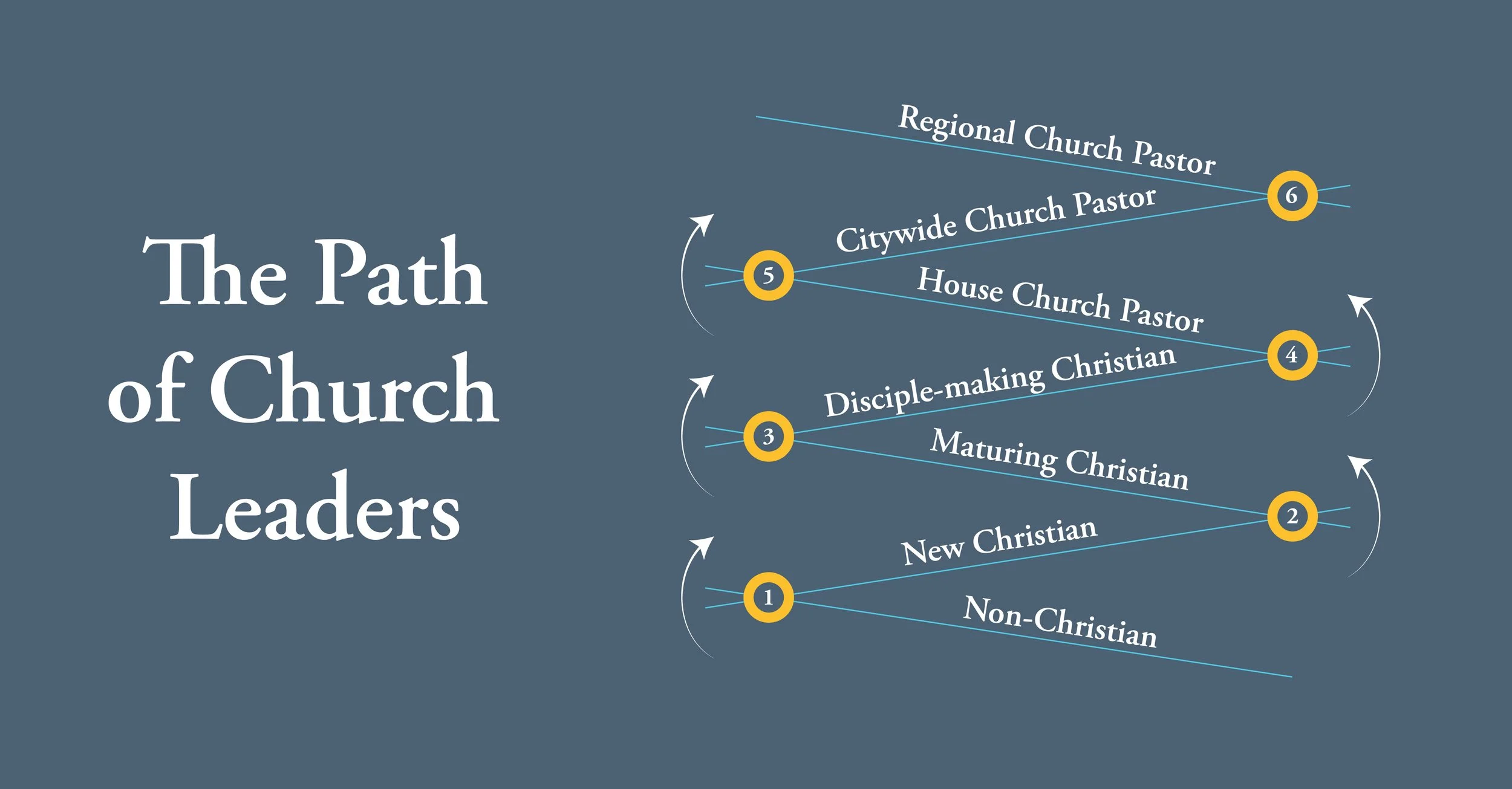The Path of Church Leaders
A leadership pipeline is a way of describing the path from one stage of development (and/or set of responsibilities) to another—with the goal of developing leaders throughout an organization.
The following points clarify our model of developing church leaders:
This model focuses on the transitions of leaders within the church. We identify and seek to facilitate six transitions: (1) from a Non-Christian to a New Christian, (2) from a New Christian to a Maturing Christian, (3) from a Maturing Christian to a Disciple-making Christian, (4) from a Disciple-making Christian to a House Church Pastor, (5) from a House Church Pastor to a Citywide Church Pastor, and (6) from a Citywide Church Pastor to a Regional Church Pastor.[1]
As part of the process of developing our training resources, we have identified the character traits, knowledge, and skills we want to cultivate at each level.
We facilitate each transition, at least in part, by using the following resources/programs. For example, to help Christians navigate Transition #2, we encourage them to study The Discipleship Series (with an emphasis on learning through discussion).
This model focuses on the transitions of leaders within the church. To the glory of God, the body of Christ is wonderfully diverse, and those who function as leaders are not superior to any other person in the body (Gen. 1:26–28; 1 Cor. 12). However, many churches struggle because they have not formally identified the nature of leadership nor the process of developing leaders. Leadership is the process by which someone influences one or more people to achieve common goals (Leadership by Hughes et al.). Christian leadership is the process by which God moves in and through a Christian to influence others to accomplish God’s purposes (including service, evangelism, discipleship, developing leaders, and loving God above all), using God’s Word as the guide. Once someone begins transition three and moves forward, they are exercising Christian leadership; they are influencing others to achieve God’s purposes, whether they view themselves as leaders or not.
This model focuses on the transitions of leaders within the church. Church-based leadership is Christian leadership that is exercised in and through the people of a local church. It requires that we influence God’s people to obey all that Jesus’s commanded, particularly those commands that God’s people must obey in their churches and families. The local church is the context in which church leaders are identified, developed, and commissioned. Men and women must first learn to follow others in a local church before they can faithfully lead in a church.
In an ideal world, churches would help current and aspiring leaders through each transition in order—including helping them to mature in the core teachings of the faith (transition two), learn to make disciples (transition three), and, for some, serve as pastors/elders/overseers (transitions four through six). But leadership development is often non-sequential and not progressive, and therefore God often loops us back to address our character issues, gaps in our knowledge, and deficiencies in our skills. For these reasons, just because someone carries the title of pastor or elder does not mean that he is well-equipped to lead within a local church. And formally appointing leaders in the church before they are ready can be damaging both for the leader and for those they lead. Even so, mapping an ideal progression is more helpful than not defining the process. Such a map outlines the overall trajectory of leaders and allows us to identify the developmental tasks along the way.
Men and women participate in transitions one through three. Both men and women are made in God’s image, and therefore have equal dignity and worth in the eyes of God (Gen. 1:26-28). Our desire is to equip men and women to make disciples of their family members, friends, and neighbors. Additionally, God uses both men and women to contribute to the strengthening of local churches (Rom. 12:1-8; Titus 2:1-10). However, only qualified men participate in transitions four through six, because God restricts the office of pastor/elder/overseer (which is one office in the New Testament) to qualified men (1 Tim. 2:12-14; 3:1-7; Titus 1:5-9).
[1] In the book The Leadership Pipeline, authors Charan, Drotter, and Noel outline the progression from managing oneself to managing an enterprise (multiple groups of businesses). In the process, they describe six leadership passages that individuals must navigate to successfully move from one level of the organization to the next, such as “From Managing Self to Managing Others.” They argue that three things need to change in order to successfully navigate a transition: skills, time allocation, and values. For example, new managers must learn new skills (such as running meetings and giving feedback to employees), new time allocations (devoting time to managing others as opposed to simply being individual contributors), and new values (valuing getting work done through others as opposed to doing the work themselves).
